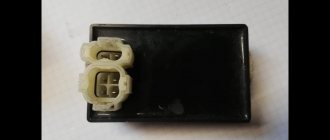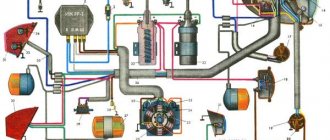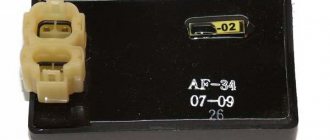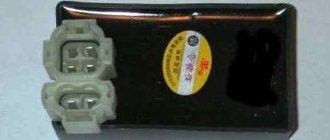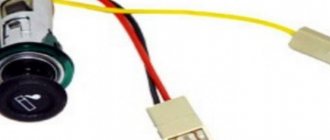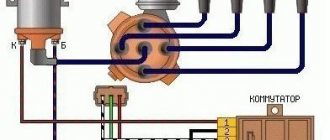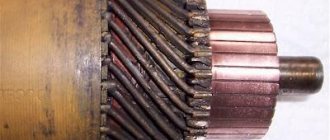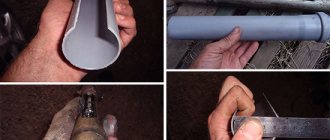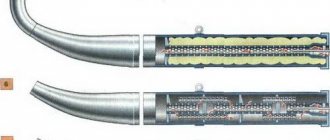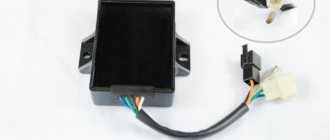Switch Purpose
The switch is designed to interrupt the electric current flowing through the primary winding of the ignition coil, according to a signal from the Hall sensor. The interruption results in a high voltage current flowing to the spark plugs.
In addition, the switch automatically regulates the period of current accumulation in the ignition coil depending on the crankshaft speed. It also turns off the current supply through the ignition coil when the engine is not running but the ignition is on.
Diagnostics of device health
It is recommended to carry out in-depth diagnostics of the device at a specialized service. A professional stand will allow you to evaluate the condition of the unit in various engine operating modes in the range from 0 to 8000 rpm. The manufacturer categorically does not recommend diagnosing using artisanal methods. This is dangerous not only for the car’s electrical system, but also for the person trying to carry out such diagnostics.
If the car’s dashboard is equipped with a voltmeter, and the car owner knows how to check the VAZ switch, then a simple way is available to him to preliminary assess the performance of the device. One of the functions of the switch is to turn off the power to the ignition coil when the engine is not running but the ignition is on. With such a shutdown, the voltage in the on-board network increases noticeably. This means that to check the functionality of the device, you should insert the key into the lock, turn it to the ignition position, but do not turn the starter. At this time, you must carefully monitor the readings on the voltmeter.
In the first seconds, the arrow will freeze approximately in the middle of the scale, and after 8-10 seconds it will noticeably move to the right. Since the device worked, the coil turned off, the voltage increased, and the voltmeter responded, then everything is in order. If a switch fails, it usually happens entirely. It is unlikely that the secondary function remained operational, but the basic one failed. So, with a high probability, the device can be considered working.
Automotive ignition system
Of course, in the VAZ-2109 car, and in other models as well, each system is very important, because it fulfills its main purpose, and failure of any system simply will not allow the car to perform its functions. Therefore, you need to monitor every system in your car, and, of course, the ignition system, without which the power unit will not be able to operate. Car owners should not consider the ignition system as a separate part, since it consists of several rather complex components, and one of the most important is the switch.
Quite often, car owners wonder: how can they check the VAZ-2109 switch and is it really possible to cope with this task on their own? We will try to understand these questions further.
Pinout and diagram of the VAZ ignition coil
Pinout of ignition coil modules for various car models of the VAZ family:
Ignition VAZ 2101
1 – generator; 2 – ignition switch; 3 – ignition distributor; 4 – breaker cam; 5 – spark plugs; 6 – ignition coil; 7 – battery.
Ignition VAZ 2106
1 – ignition switch; 2 – fuse and relay block; 3 – EPHH control unit; 4 – generator; 5 – solenoid valve; 6 – microswitch; 7 – spark plugs; 8 – ignition distributor; 9 – ignition coil; 10 – battery.
Ignition VAZ 2108, 2109
Ignition VAZ 2110
Ignition VAZ 2111
Ignition VAZ 2112
Ignition VAZ 2114
Diagram of a non-contact ignition system: 1 – non-contact sensor; 2 – ignition distributor sensor; 3 – spark plugs; 4 – switch; 5 – ignition coil; 6 – mounting block; 7 – ignition relay; 8 – ignition switch.
What signs indicate a faulty switch?
The most obvious sign of a faulty switch is the loss of the so-called spark, as well as interruptions in the operation of the engine, for example, it may begin to have difficulty starting and quickly stall even after warming up.
It is not recommended to immediately change the switch due to loss of spark, since such a malfunction is sometimes caused by other automotive components that fail:
- Hall Sensor;
- timing belt rupture;
- poor contact in the distributor;
- ignition coil failure. If a malfunction is detected in this particular element, then, according to experts, the coil needs to be replaced rather than wasting time on repairing it.
If diagnostics of the components described above confirm their serviceability, you will have to begin checking a more complex device called a switch.
Video on repairing KZ VAZ
Every owner of the VAZ 2109 should know the ignition circuit Without knowing this circuit, you will not be able to start the car in case of ignition problems. Moreover, this scheme is elementary simple. The VAZ 2109 is equipped with a contactless ignition system. It consists of the following components: switch, ignition coil, distributor, Hall sensor, high-voltage wires and spark plugs. The task of the ignition system is to provide a timely, cyclic spark to the engine cylinders. Let's take a closer look at how the clamping circuit works.
Ignition circuit for VAZ 2109
ignition of the VAZ 2109: power is supplied to the ignition system through a relay. Until the key is in the ignition position, the relay will not turn on and supply power to the circuit. As soon as the key is turned, the ignition system is energized. +12V power from the battery is supplied to contact B of the ignition coil, the 4th contact of the switch. The Hall sensor powers the switch itself. Please note that the ignition relay is powered through the mounting block, and if there is poor contact in connectors Ш1, Ш8 or for some reason the track oxidizes or burns out, the ignition system will not be powered and the VAZ 2109 will not start. In order for a spark to begin to form, you need to crank the engine crankshaft. Together with it, the camshaft will turn and the Hall sensor will send an impulse to the switch. The commutator, in turn, will connect contact K of the ignition coil to ground, resulting in a spark appearing on the central wire. When the distributor slider connects the central wire and the wire leading to a specific engine cylinder, a spark will jump on the spark plug, igniting the combustible mixture. The engine will start. When it is necessary to turn off the engine, the driver, by turning the key in the ignition switch, turns off the relay, which in turn disassembles the power supply to the system. The switch and ignition coil become de-energized and stop working. The most common malfunctions of the VAZ 2109 ignition system: 1) Failure of the switch. 2) Failure of the Hall sensor. 3) Poor contact of the slider in the distributor. 4) Lack of power supply to the ignition system of the VAZ 2109. Go to Home.
Self-test of the switch
To check the operation of the switch yourself, you will need a set of regular car keys.
The rated voltage is measured with a multimeter and a special light bulb, the value of which should be no more than 12 V. It is quite easy to independently check the functionality of the switch if you carry out this step step by step:
- The battery must be disconnected from the power supply to prevent short-circuiting the wiring.
- Using a size 8 wrench, unscrew the fastener from the wire that goes to the ignition coil. Finding this wiring is quite simple by marking “K”.
- The disconnected wire must be connected to a control light and a clamp that has the same marking “K”.
- Next, you should connect this wire to the battery.
- After turning on the car starter, you need to observe the so-called behavior of the warning light. If the switch is working, the light will periodically turn on and off, and if it does not perform any actions, then the device can be considered incompetent and will need to be replaced.
At this point, the process of checking the switch is considered complete, and, as many can see, it is very simple and understandable. Therefore, you should not immediately turn to a service station for a solution to this issue and spend a rather impressive amount of money. First of all, you should try to test this device yourself, and if difficulties still arise, you can watch a training video on an Internet resource at any time, conducted by real masters of their craft.
If the VAZ-2109 car owner doubts the serviceability of the element, then it is best to check its operation at the test stand, which is provided at each service station. Using such a stand, not only the functionality of the switch is checked, but also the duration of the pulse generated by this device.
Alternative diagnostic methods
When there is no voltmeter on the dashboard, you can get out of the situation by doing everything yourself. To do this, you will need a 12 V light bulb and two meter wires with stripped ends. The diagnostic work flow diagram is as follows:
- disconnect the battery, de-energize the electrical system;
- using a size 8 wrench, unscrew the nut and remove the wire from the ignition coil terminal marked “K”, this wire is brown and goes to the clamp marked “1” on the switch;
- connect this wire to one of the test lamp wires;
- Connect the other wire of the control lamp to terminal “K” on the ignition coil;
- connect the battery;
- Turn on the engine starter and observe the condition of the lamp. If the lamp is flashing, the device is working properly. If the lamp does not light, the device is faulty.
How to check a VAZ 2109 switch
The switch is the very part of the car’s ignition system that can easily fail, but is difficult to diagnose. Is this really so? Let’s find out using the example of a VAZ 2109 car. Let’s consider why it is needed and how to check it in case of a malfunction of the ignition system.
Purpose of the VAZ 2109 switch
The switch is an electronic unit that is responsible for programming and controlling the vehicle’s ignition system. Its basis is the well-known L497 microcircuit, which is used to control transistors.
The advantages of using a switch over conventional contact ignition are reliability, since the electronics make it easier to start the engine even at the lowest temperatures, which indicates good sparking. In addition, the switch is securely mounted, which ensures trouble-free operation.
With proper adjustment of the switch, you can increase the rotation speed and speed of the engine crankshaft and directly influence its traction properties. Correct operation of the switch is ensured through the use of a Hall sensor installed on the engine distributor.
Signs or symptoms of a bad switch?
Perhaps the main symptom of a block failure is the absence of a spark when starting the engine. This happens as follows: the starter successfully rotates the engine, but the mixture does not ignite. The engine shows absolutely no signs of life at all. Spark plugs are usually wet and quickly fail.
First of all, all other elements of the system are checked - these are armored wires, Hall sensor, ignition coil and spark plugs. In addition, it is necessary to ensure that the timing system is in good working order. If everything is in order, it’s time to check the switch on the VAZ 2109.
How to check the switch?
First, you need to find out some characteristics of the device in order to avoid mistakes during diagnostics.
- The device voltage ranges from 6 to 16 Volts
- Operating (standard) voltage – at least 13.5 Volts
- Switching current – 7.5-8.5 Volts
- Guaranteed good spark at rpm from 20 to 7000.
This is what characterizes the good performance of the device. If at least one of these points is missing, then the switch has become unusable. And now about checking the device.
First you need to take a size 8 key and unscrew the nut securing the wire to contact “K” on the ignition coil. As a rule, it is brown in color. Try not to let it come into contact with the car body, as this may cause a short circuit.
Now you need to take a 12-volt test lamp and connect one end of it to contact “K” and the other to the brown wire. Ensure good contact - this will be the key to competent diagnosis of the problem.
Make sure the lamp is visible from inside the car. Get behind the wheel, turn on the ignition and try to start the engine. If the light blinks while the engine is cranked by the starter, it means the switch is working. If the lamp does not light up at all, then the device must be replaced.
If you have the slightest doubt about the serviceability of the device, you can take it to a service station. There is a special stand that will not only determine the operation of the switch, but also measure the length of the pulses and compare them with the nominal value. High-precision instruments allow for broader diagnostics, but this costs a lot of money.
Fortunately, the cost of a new device is not so high - only 300-400 rubles. It is recommended to carry a spare switch in the glove compartment of your car. This will help avoid many troubles in the event of a sudden breakdown of the device. We wish you good luck on the roads!
The switch is the basis for uninterrupted engine operation
The VAZ 2109 car is equipped with a contactless ignition system.
The system includes spark plugs, four high-voltage wires (one for each spark plug), a Hall sensor, a distributor, an ignition coil and, in fact, a switch.
Rice. 1 Ignition circuit of VAZ 2109 Schematic illustration.
The ignition system generates an electrical impulse (spark), thereby igniting the mixture of fuel and air in the combustion chambers necessary for engine operation.
The switch is responsible for the cyclic supply of pulses to the ignition coil, this is necessary for the proper operation of the entire system as a whole.
Thus, if the switch is faulty, the spark will supply intermittently or be completely absent. It is not possible to drive such a car.
The VAZ 2109 switch itself consists of an aluminum case and a microcircuit installed on it. The device is mounted in the engine compartment and connected by wires to the ignition coil.
Rice. 2 Appearance of the VAZ 2109 switch.
The design of the housing and the mounting method allow the switch to successfully withstand vibrations that occur when the car is moving.
The VAZ 2109 contactless ignition system switch has the following performance characteristics:
- Voltage range 6–16 Volts.
- Operating voltage 13.5 Volts.
- Switching current 7.5–8.5 Amperes.
- A switch in good condition ensures an uninterrupted supply of spark to the cylinders with a crankshaft speed of up to 7000 rpm.
Tip: An aluminum radiator on the switch body is necessary for heat transfer from the heating device. Sometimes it needs to be cleaned of contamination to avoid overheating of the microcircuit.
VAZ 2109 - checking and replacing the switch
The voltage switch installed on the VAZ 2109 car is responsible for supplying control pulses to the ignition coil. A complete test of the switch must be carried out on a special stand, which will allow you to determine the duration of the supplied pulse. At home, using a test lamp you can only determine the presence of a pulse or its absence.
The switch is located in the engine compartment on the body partition separating the engine compartment and the vehicle interior. To check and replace, prepare a standard set of tools; you will also need a 12 V standard voltage test lamp.
Do the following sequence of actions:
- First of all, you need to de-energize the car by disconnecting the minus terminal from the battery.
- Next, use an eight-mm wrench to unscrew the nut and disconnect the red-brown wire from the ignition coil from terminal “K”, which goes to terminal “1” of the switch.
- Now we connect this wire through a test lamp to its terminal “K” of the ignition coil and, having connected the battery, turn on the engine starter. The lamp should blink, which will indicate the serviceability of the switch, which supplies a control pulse to the coil. If the lamp does not blink, then we are replacing the switch.
Before dismantling, disconnect the battery.
- Squeeze the plastic clip and disconnect the block with the power wires.
- Unscrew the two screws securing the switch to the car body and remove it complete with the aluminum radiator, which is necessary for cooling.
- Install the new one in reverse order.
At this point, the repair work to check and replace the VAZ 2109 switch is completed. While operating the car, periodically clean the radiator, as it gets very hot.
Relay and fuse box diagram 2109
The fuse blocks do not depend on the fuel injection system used - carburetor or injector. BP will differ only by year of manufacture of the car. That is, the mounting blocks for the carburetor and injector are the same. The VAZ 2109-099 fuse box (carburetor, injector) is located under the hood, in the compartment in front of the windshield on the left side.
Fuse block 2114-3722010-18
K1-relay for turning on headlight cleaners; K2-relay-breaker for direction indicators and hazard warning lights; K3 - windshield wiper relay; K4-relay for monitoring the health of lamps; K5-power window relay; K6 - relay for turning on sound signals; K7-relay for turning on the electric heating of the rear window; K8-relay for high beam headlights; K9-relay for low beam headlights; F1-F16 - fuses.
Fuse block 2114-3722010-60
K1 - Headlight wiper relay, K2 - Turn signal and hazard warning relay, K3 - Windshield wiper relay, K4 - Brake light and parking light relay, K5 - Power window relay, K6 - Horn relay , K7 - Rear window heating relay, K8 - Headlight high beam relay, K9 - Headlight low beam relay, F1 - F16 - Fuses, F1 - F20 - Spare fuses.
Attention! The power terminals on the generator often become loose, heat up, spark and melt the wiring. Pay attention to this point when searching for possible faults yourself.
Signs of a broken switch
During the operation of the car, unpleasant symptoms may occur, indicating a malfunction of the ignition system.
A possible reason for this may be incorrect operation of the switch. Here are the most common symptoms that should suggest a possible breakdown of this device:
- Can't start the engine. There is no spark when the starter is running.
- The engine starts and runs normally at low and medium speeds, but cannot be revved up at high speeds. The engine is not running at full power.
- The car stalls when moving away, although it idles stable.
- The engine starts, but does not run for a long time and immediately stalls.
- The engine begins to operate unstably - “triple”, reaching a certain speed level. When cold it can start quite normally.
- The engine may periodically, without any pattern, stall, then work normally again. The battery discharge indicator lights up. The tachometer needle shows sharp changes in the number of revolutions.
Tip: Signs of a malfunction in the ignition system can arise not only from the switch, but also from failure of other components. Replacing a switch with the above symptoms does not always help fix the problem. Therefore, it is advisable to carry out diagnostics of the ignition system in a comprehensive manner, step by step checking the serviceability of all components.
Switch design and malfunctions
The VAZ 2109 switch is one of the key elements of the car’s ignition system. The device is designed to switch current pulses of the required amplitude and duration in the primary winding of the ignition coil, depending on the control pulses of the Hall sensor. It also stabilizes the current from 6 to 18 V, protects semiconductors from overloads and ensures that the ignition system is turned off when the engine is stopped.
The housing provides a connection to ground through a radiator. When the device operates, a significant amount of heat is generated through its radiator. During operation, the radiator should be regularly cleaned of all kinds of contaminants to maintain heat transfer.
Signs of a faulty switch may include the following:
- when the starter is turned on, the engine does not start, there is no spark at the spark plugs;
- the engine starts, but soon stalls at idle;
- The engine runs unsteadily and the spark sometimes disappears.
A malfunction of the VAZ switch is not the only possible reason for the appearance of such symptoms. Such signs can be observed when the distributor fails or contact is lost.
To carry out repairs correctly, a thorough diagnosis is necessary.
What is and what is the principle of operation of the ignition switch
Even on the very first cars, battery ignition systems were used to ignite the combustible mixture, the functional diagram of which is shown in the figure.
This figure allows you to understand that its work is based on the principle of self-induction. When the current flow circuit in the winding of bobbin 3 is broken, a high-voltage EMF is induced in the secondary, causing a spark to appear on the contacts of spark plug 2. The circuit break is caused by the opening of the contacts of breaker 6.
Without touching on the advantages or disadvantages, it should be noted that this scheme worked on the car for a long time. And only the emergence of a new element base gave impetus to the further development of such a device, preserving the original principle of its operation.
BZS adjustment
Adjusting the ignition of the VAZ 2107 begins with the simplest operation of removing the distributor cover, then turning the crankshaft until the maximum distance between it and the distributor is reached.
Installation process of BZS VAZ 2107
After this, they begin to unscrew the screws that fix the contact group on the bearing plate and between the contacts, insert a probe to determine and select the optimal position for the group
Contact angle correction in closed state
Ideally, everything is determined by the force applied to move the probe, which should be minimal; having found an area that meets this requirement, the position of the group is fixed by tightening the screws. The size of the gap also matters; to determine it, the thickness of the feeler gauge should be 0.44 millimeters. It is the adjustment of the gap that provides the required value of the angle of closed contacts; its optimal value is 55±3°.
Sources:
- https://ladaautos.ru/vaz-2109/kak-mozhno-proverit-kommutator-vaz-2109.html
- https://chinisam.ru/vaz/3204-kak-proverit-kommutator-vaz-2109.html
- https://zubilovaz.ru/vaz-2109-proverka-i-zamena-kommutatora
